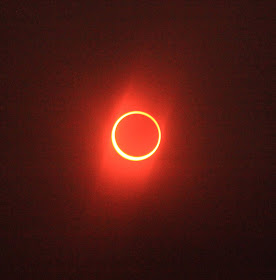This past weekend was Member's Gathering for the Grand Canyon Association and 142 members from around the country showed up to show their support for our favorite national park non-profit. I gave two lectures to 70 members and took another 25 members on a guided walk along the Trail of Time.
But Earth's biggest star, the Sun, was the headliner this weekend. It was eclipsed by the the moon, far enough away from the earth this week to create an annular or ring eclipse. I've been aware of this eclipse for at least two years and jokingly advised people that the center line of the eclipse (where the eclipse lasts the longest) would pass directly through the Jack-in-the-Box restaurant in Page, Arizona. See the map below and note that the entire southern half of the Colorado Plateau got to experience this event.
When Member's Gathering was over, Helen and I went to a viewpoint on the rim of Grand Canyon that did not have any paved road or trail to it. Only one other person was there with us. I took some photo's during the late afternoon, using a solar filter on my camera lens. You'll see the pictures of the eclipse at the end of this posting, the first photo's are of us and the canyon taken from our perch.
Here's Helen sitting on the Rim at the spot we selected to view the eclipse
Those who know the Grand Canyon landscape will see that we decided to view the eclipse from the East Rim portion of the canyon. This is a view towards the "Big Bend" of the Colorado River beneath Desert View.
We had a great view of Hance Rapid from our perch and the roar of the rapid was easily heard by us as the eclipse proceeded. Interestingly, Helen and I were supposed to be on a private river trip during the eclipse and might possibly have been near here on this date. A shaft of sunlight was still beaming down on the white sand dune near the rapid as the eclipse went full. Then, it disappeared soon thereafter.
Helen using an eclipse viewer
What a scene for such a celestial event
We noticed that the light became duller and slightly metallic as full occlusion came about. We both wondered if we would have noticed anything strange about the light had we not known about the eclipse. We agreed that we would have noticed the light becoming dimmer (and the air becoming cooler) but when we glanced in the direction of the sun at the height of the eclipse, the sun looked as bright an full as ever! Truly unbelievable considering that 88 to 94% of the disk was covered.
Here is a look at the walls of the canyon during full occlusion at about 6: 35 PM
Our rocky perch looking west with the moon still covering about half of the sun's disk
A bench mark nearby showed that the elevation was 7284 ft. above sea level. No date was on the marker.
Recent fires in Arizona gave an eerily orange glow to the canyon just before sunset
The final light falls on the walls of the Palisades of the Desert near Desert View
The eclipse began at 5:28. This is what it looked like at 5:46 PM. (Note that all times given are very close but approximate, and based solely on the timer in my camera on this date).
6:00 PM
6:05 PM
6:28 PM - just 6 minutes away from the beginning of the annular phase
6:30:19 PM
6:32:22 PM
6:33:22 PM
And here it is 6:34 PM
6:34:32 PM
6:34:36 PM
6:35:19 PM
6:35:22 PM
6:37 PM
6:46 PM
7:13 PM.
Sunset on this date at Grand Canyon was 7:32 and a fraction of the eclipse was still happening as the sun set. Here is the final picture taken at 7:29:36 as the sun was setting behind Havasupai Pt. (to the right). You can still see in the upper left the last part of the eclipse. What a spectacle we experienced.
The happy couple enjoying a celestial phenomenon in our favorite landscape! Below is a graph showing the timing of the eclipse through northern Arizona.































Nice series of the eclipse. I took over 100 photos and haven't had time to do anything with them. I was in awe.
ReplyDeleteAbsolutely fantastic in every way! What a tremendous post and amazing photos!!!!!! Jack
ReplyDelete